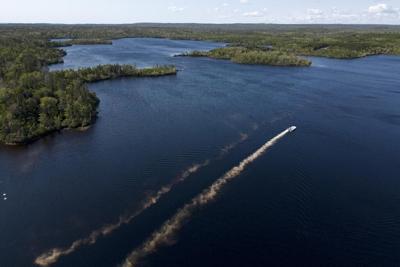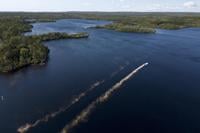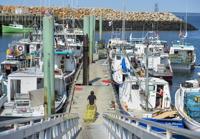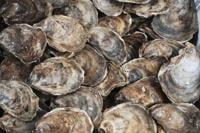HALIFAX - Nearly one year after Nova Scotia's Fisheries Department treated a lake with chemicals to eradicate invasive smallmouth bass, there are early signs of success.
Last September, the department introduced 1,500 litres of a solution containing the pesticide rotenone into Dobsons Lake, near Canso, N.S. In use since the 1950s, rotenone targets fish gills and inhibits breathing, while leaving birds and mammals unaffected. However, the pesticide will cause all the fish in the treatment area to die.
The goal of the operation was to rid the 52-hectare lake in eastern Nova Scotia of invasive smallmouth bass in an attempt to protect the native brook trout that populate a series of rivers in the nearby Cole Harbour watershed.
Andrew Lowles, manager of resource management with the department’s inland fisheries division, said brook trout have since been observed naturally migrating upstream, while there have been no signs of smallmouth bass in the lake.
“It’s still early to call Dobson Lake a total success, but at this point we have no indication that smallmouth bass were not eradicated,” Lowles said in a recent interview.
He said the department made the observations last fall and this past spring and plans to return with a followup assessment early next month.
Prior to using the pesticide, the department removed brook trout and minnows from the lake, and it is now also trying to repopulate the watershed area with the fish from another lake in the same system, said Lowles.
The growing problem with smallmouth bass was first identified in the spring of 2020 when the department received reports that the species had been illegally transferred into the lake.
The use of rotenone at Dobsons Lake followed a similar successful fish kill at Piper Lake, in Pictou County, that was carried out in October 2020.
At Piper, which at five hectares is much smaller than Dobsons, an estimated 500 smallmouth bass were physically removed from the shallow lake, Lowles said, through the use of rotenone and by netting and electro-fishing, which involves temporary stunning fish with a rod or specialized boat.
Lowles said physical removal of dead fish from Dobsons wasn’t practical because of its size, with more bays and deeper water.
”We left many of those (dead) fish to return their nutrients back into the system,” he said. “We really don’t have a good estimate of bass from Dobsons.”
And while rotenone doesn't kill mammals or birds, it can affect amphibious invertebrates such as frogs and salamanders early in their life cycle, when they still breathe through gills.
Lowles said some frogs have since been observed along the shoreline of Dobsons Lake, while four species of frogs have been observed at Piper Lake — an area where two species had formerly been observed. Aquatic organisms such as zooplankton have also rebounded at the smaller lake, he said.
“Everything that was there (at Piper) pre-treatment was back within a year post treatment.”
A number of sport fishing and ecological organizations in Nova Scotia have largely supported the use of the chemical as a last resort in protecting ecosystems threatened by invasive fish species.
Scott Beaver, of the St. Mary's River Association, said he’s satisfied that at least in the case of Piper Lake, the province made the right choice and acted quickly to protect the salmon population in the St. Mary's River system.
“We are happy with the results there, but I don’t necessarily think that it’s an application you would use in every situation,” Beaver said in an interview.
“Maybe in some cases an invasive species may have gotten too far out of control. You couldn’t do the entire river system for instance, at some point you almost have to accept the fact that they are there.”
Raymond Plourde, senior wilderness coordinator for the Halifax-based Ecology Action Centre, has previously expressed support for the pesticide’s use in the two Nova Scotia lakes but also called the measure “less than ideal.”
But Plourde said the threat to native species, such as salmon and brook trout, is real from warm water invasives such as smallmouth bass and chain pickerel, both of which are thriving as a result of climate change.
“Invasives are one of the leading causes of biodiversity decline in native species … and they are essentially being spread by people from one watershed to another,” he said. “It is a very serious thing and desperate times call for desperate measures.”
Lowles said there are no immediate plans to use the chemical anywhere else, but he didn’t rule out its future use.
“If we could prevent the spread through education and legislation it’s the most effective thing,” he said, while adding that “we would prefer not to have to use rotenone.”
“You can use nets and mechanical removals for containment and to suppress populations for the short term, but rotenone is likely the only method for total eradication.”
This report by şĂÉ«tvwas first published Aug. 24, 2023.
Note to readers: This is a corrected story. A previous version said that electro-fishing involves fatally shocking fish.








































